Decay Kinetics of Gd3Al2Ga3O12:Ce3+ Luminescence under Dense Laser Irradiation
Abstract
:1. Introduction
2. Experimental Details
2.1. Crystal Growth
2.2. XRD Studies
2.3. Luminescence Spectroscopy
3. Results and Discussion
3.1. XRD Studies
3.2. Influence of Excitation Density on the Decay Curves of GAGG:Ce
3.3. Z-Scans of GAGG:Ce
3.4. Discussion
4. Conclusions
Supplementary Materials
Author Contributions
Funding
Institutional Review Board Statement
Informed Consent Statement
Data Availability Statement
Acknowledgments
Conflicts of Interest
References
- Lecoq, P. Development of new scintillators for medical applications. Nucl. Instrum. Methods Phys. Res. Sect. A 2016, 809, 130. [Google Scholar] [CrossRef]
- Ogiegło, J.M.; Katelnikovas, A.; Zych, A.; Justel, T.; Meijerink, A.; Ronda, C.R. Luminescence and Luminescence Quenching in Gd3(Ga,Al)5O12 Scintillators Doped with Ce3+. J. Phys. Chem. A 2013, 117, 2479. [Google Scholar] [CrossRef] [PubMed]
- Bartosiewicz, K.; Babin, V.; Kamada, K.; Yoshikawa, A.; Kurosawa, S.; Beitlerova, A.; Kucerkova, R.; Nikl, M.; Zorenko, Y. Ga for Al substitution effects on the garnet phase stability and luminescence properties of Gd3GaxAl5-xO12:Ce single crystals. J. Lumin 2019, 216, 116724. [Google Scholar] [CrossRef]
- Wu, Y.; Meng, F.; Li, Q.; Koschan, M.; Melcher, C.L. Role of Ce4+ in the Scintillation Mechanism of Codoped Gd3Ga3Al2O12:Ce. Phys. Rev. Appl. 2014, 2, 044009. [Google Scholar] [CrossRef] [Green Version]
- Suzuki, H.; Tombrello, T.A.; Melcher, C.L.; Peterson, C.A.; Schweitzer, J.S. The role of gadolinium in the scintillation processes of cerium-doped gadolinium oxyorthosilicate. Nucl. Instrum. Methods Phys. Res. Sect. A 1994, 346, 510. [Google Scholar] [CrossRef]
- Vasil’ev, A.N.; Gektin, A.V. Multiscale Approach to Estimation of Scintillation Characteristics. IEEE Trans. Nucl. Sci. 2014, 61, 235. [Google Scholar] [CrossRef]
- Bizarri, G.; Moses, W.W.; Singh, J.; Vasil’ev, A.N.; Williams, R.T. The role of different linear and non-linear channels of relaxation in scintillator non-proportionality. J. Lumin. 2009, 129, 1790. [Google Scholar] [CrossRef]
- Kirm, M.; Nagirnyi, V.; Feldbach, E.; De Grazia, M.; Carre, B.; Merdji, H.; Guizard, S.; Geoffroy, G.; Gaudin, J.; Fedorov, N.; et al. Exciton-exciton interactions in CdWO4 irradiated by intense femtosecond vacuum ultraviolet pulses. Phys. Rev. B 2009, 79, 233103. [Google Scholar] [CrossRef]
- Laasner, R.; Fedorov, N.; Grigonis, R.; Guizard, S.; Kirm, M.; Makhov, V.; Markov, S.; Nagirnyi, V.; Sirutkaitis, V.; Vasil’ev, A.; et al. Band tail absorption saturation in CdWO4 with 100 fs laser pulses. J. Phys. Condens. Matter 2013, 25, 245901. [Google Scholar] [CrossRef]
- Markov, S.; Nagirnyi, V.; Vasil’ev, A.; Makhov, V.; Laasner, R.; Vielhauer, S.; Kirm, M.; Grigonis, R.; Sirutkaitis, V. Modelling of decay kinetics of self-trapped exciton luminescence in CdWO4 under femtosecond laser excitation in absorption saturation conditions. Open Phys. 2012, 10, 1002. [Google Scholar] [CrossRef]
- Spassky, D.; Vasil’ev, A.; Belsky, A.; Fedorov, N.; Martin, P.; Markov, S.; Buzanov, O.; Kozlova, N.; Slegel, V. Excitation density effects in luminescence properties of CaMoO4 and ZnMoO4. Opt. Mater. 2019, 90, 7. [Google Scholar] [CrossRef]
- Belsky, A.; Fedorov, N.; Gridin, S.; Gektin, A.; Martin, P.; Spassky, D.; Vasil’ev, A. Time-resolved luminescence z-scan of CsI using power femtosecond laser pulses. Radiat. Meas. 2019, 124, 1–8. [Google Scholar] [CrossRef]
- Nikl, M.; Mares, J.A.; Dusek, M.; Lecoq, P.; Dafinei, I.; Auffray, E.; Pazzi, G.P.; Fabeni, P.; Jindra, J.; Skoda, Z. Decay kinetics of Ce3+ ions under gamma and KrF excimer laser excitation in CeF3 single crystals. J. Phys. Condens. Matter 1995, 7, 6355. [Google Scholar] [CrossRef]
- Belsky, A.N.; Glukhov, R.A.; Kamenskikh, I.A.; Martin, P.; Mikhailin, V.V.; Munro, I.H.; Pedrini, C.; Shaw, D.A.; Shpinkov, I.N.; Vasil’ev, A.N. Luminescence quenching as a probe for the local density of electronic excitations in insulators. J. Electron Spectrosc. Relat. Phenom. 1996, 79, 147. [Google Scholar] [CrossRef]
- Krzywinski, J.; Andrejczuk, A.; Bionta, R.M.; Burian, T.; Chalupský, J.; Jurek, M.; Kirm, M.; Nagirnyi, V.; Sobierajski, R.; Tiedtke, K.; et al. Saturation of a Ce:Y3Al5O12 scintillator response to ultra-short pulses of extreme ultraviolet soft X-ray and X-ray laser radiation. Opt. Mater. Express 2017, 7, 665. [Google Scholar] [CrossRef]
- Williams, R.T.; Grim, J.Q.; Li, Q.; Ucer, K.B.; Moses, W.W. Excitation density, diffusion—Drift, and proportionality in scintillators. Phys. Status Solidi B 2011, 248, 426. [Google Scholar] [CrossRef]
- Kamada, K.; Yanagida, T.; Endo, T.; Tsutumi, K.; Usuki, Y.; Nikl, M.; Fujimoto, Y.; Fukabori, A.; Yoshikawa, A. 2 inch diameter single crystal growth and scintillation properties of Ce:Gd3Al2Ga3O12. J. Cryst. Growth 2012, 352, 88. [Google Scholar] [CrossRef]
- Spassky, D.; Kozlova, N.; Zabelina, E.; Kasimova, V.; Krutyak, N.; Ukhanova, A.; Morozov, V.A.; Morozov, A.V.; Buzanov, O.; Chernenko, K.; et al. Influence of Sc cation substituent on structural properties and energy transfer processes in GAGG:Ce crystals. CrystEngComm 2020, 22, 2621. [Google Scholar] [CrossRef]
- Sibczynski, P.; Iwanowska-Hanke, J.; Moszyński, M.; Swiderski, L.; Szawłowski, M.; Grodzicka, M.; Szczęśniak, T.; Kamada, K.; Yoshikawa, A. Characterization of GAGG:Ce scintillators with various Al-to-Ga ratio. Nucl. Instrum. Methods Phys. Res. Sect. A 2015, 772, 112. [Google Scholar] [CrossRef]
- Tamulaitis, G.; Vasil’ev, A.; Korzhik, M.; Mazzi, A.; Gola, A.; Nargelas, S.; Vaitkevičius, A.; Fedorov, A.; Kozlov, D. Improvement of the Time Resolution of Radiation Detectors Based on Gd3Al2Ga3O12 Scintillators with SiPM Readout. IEEE Trans. Nucl. Sci. 2019, 66, 1879. [Google Scholar] [CrossRef]
- Prusa, P.; Kucera, M.; Mares, J.A.; Onderisinova, Z.; Hanus, M.; Babin, V.; Beitlerova, A.; Nikl, M. Composition Tailoring in Ce-Doped Multicomponent Garnet Epitaxial Film Scintillators. Cryst. Growth Des. 2015, 15, 3715. [Google Scholar] [CrossRef]
- Tanaka, M.; Katsuya, Y.; Yamamoto, A. A new large radius imaging plate camera for high-resolution and high-throughput synchrotron X-ray powder diffraction by multiexposure method. Rev. Sci. Instrum. 2008, 79, 075106. [Google Scholar] [CrossRef] [PubMed]
- Tanaka, M.; Katsuya, Y.; Matsushita, Y.; Sakata, O. Development of a synchrotron powder diffractometer with a one-dimensional X-ray detector for analysis of advanced materials. J. Ceram. Soc. Jpn. 2013, 121, 287. [Google Scholar] [CrossRef] [Green Version]
- Petricek, V.; Dusek, M.; Palatinus, L. Crystallographic Computing System JANA2006: General features. Z. Krist.-Cryst. Mater. 2014, 229, 345. [Google Scholar] [CrossRef]
- Abrahams, S.C.; Geller, S. Refinement of the structure of a grossularite garnet. Acta Crystallogr. 1958, 11, 437. [Google Scholar] [CrossRef]
- AFLOW. Available online: https://aflow.org/material/?id=aflow:0d48f6442e93b38d (accessed on 29 November 2022).
- Laguta, V.; Buryi, M.; Pejchal, J.; Babin, V.; Nikl, M. Hole Self-Trapping in Y3Al5O12 and Lu3Al5O12 Garnet Crystals. Phys. Rev. Appl. 2018, 10, 034058. [Google Scholar] [CrossRef]
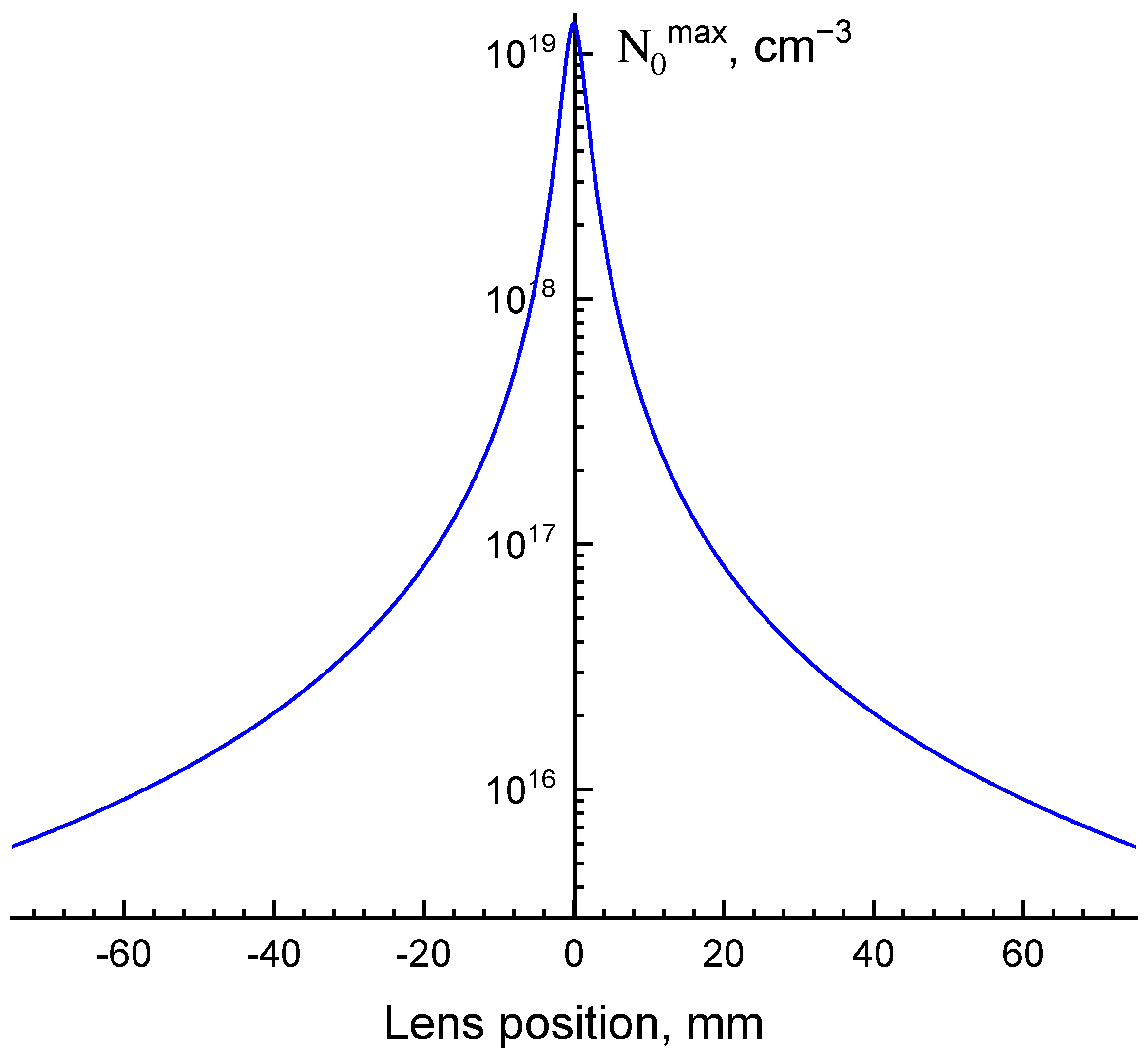
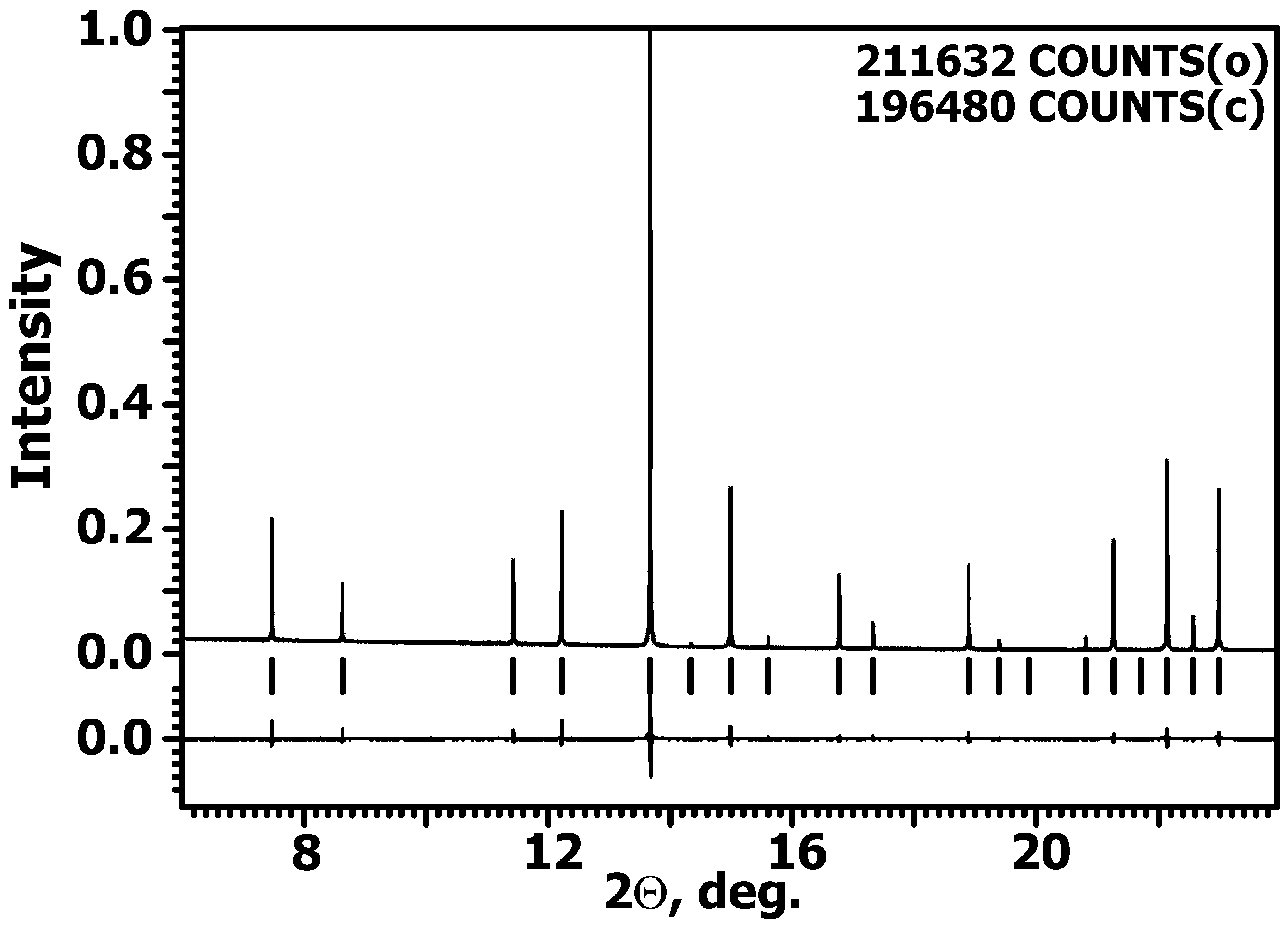
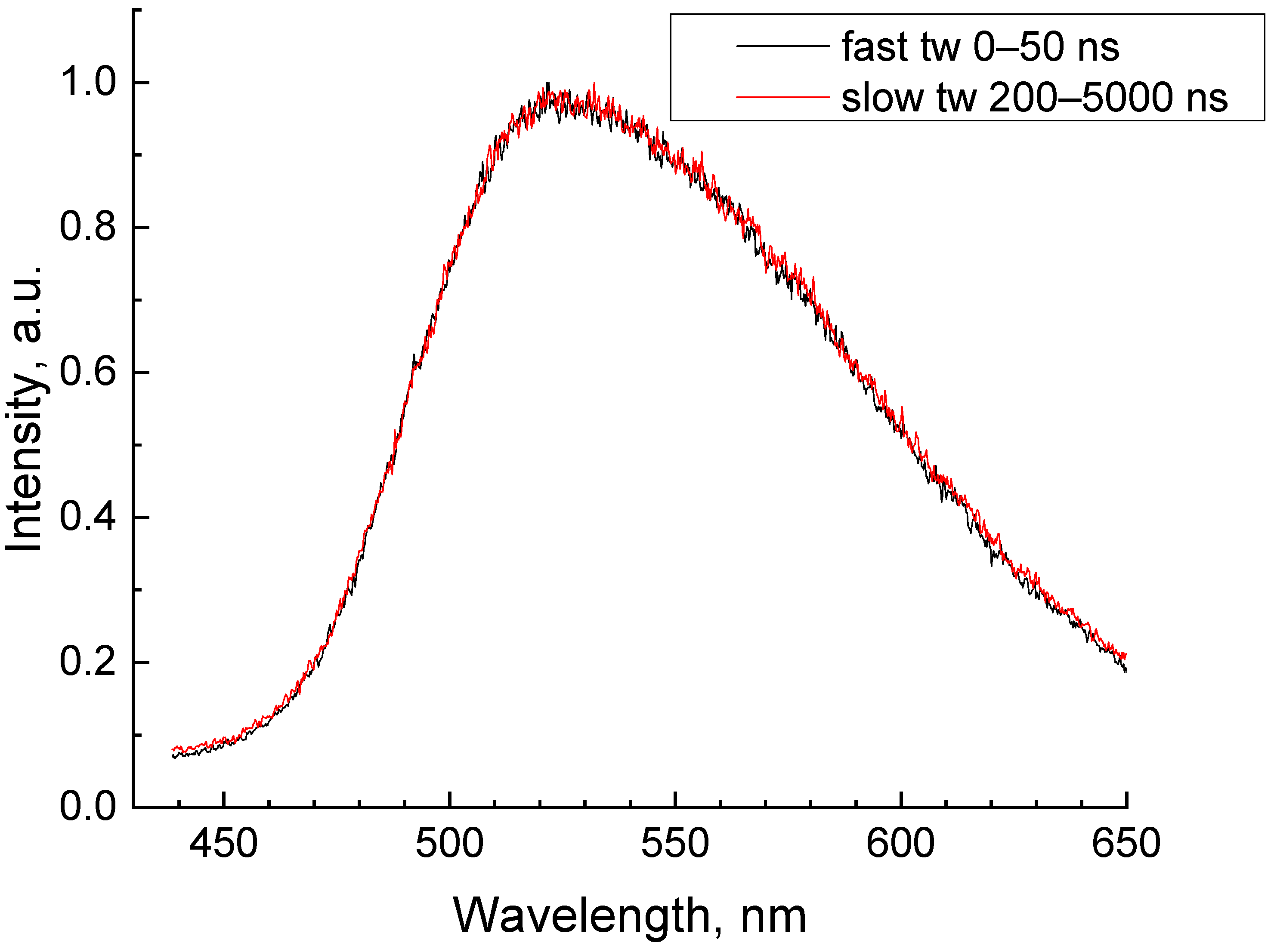
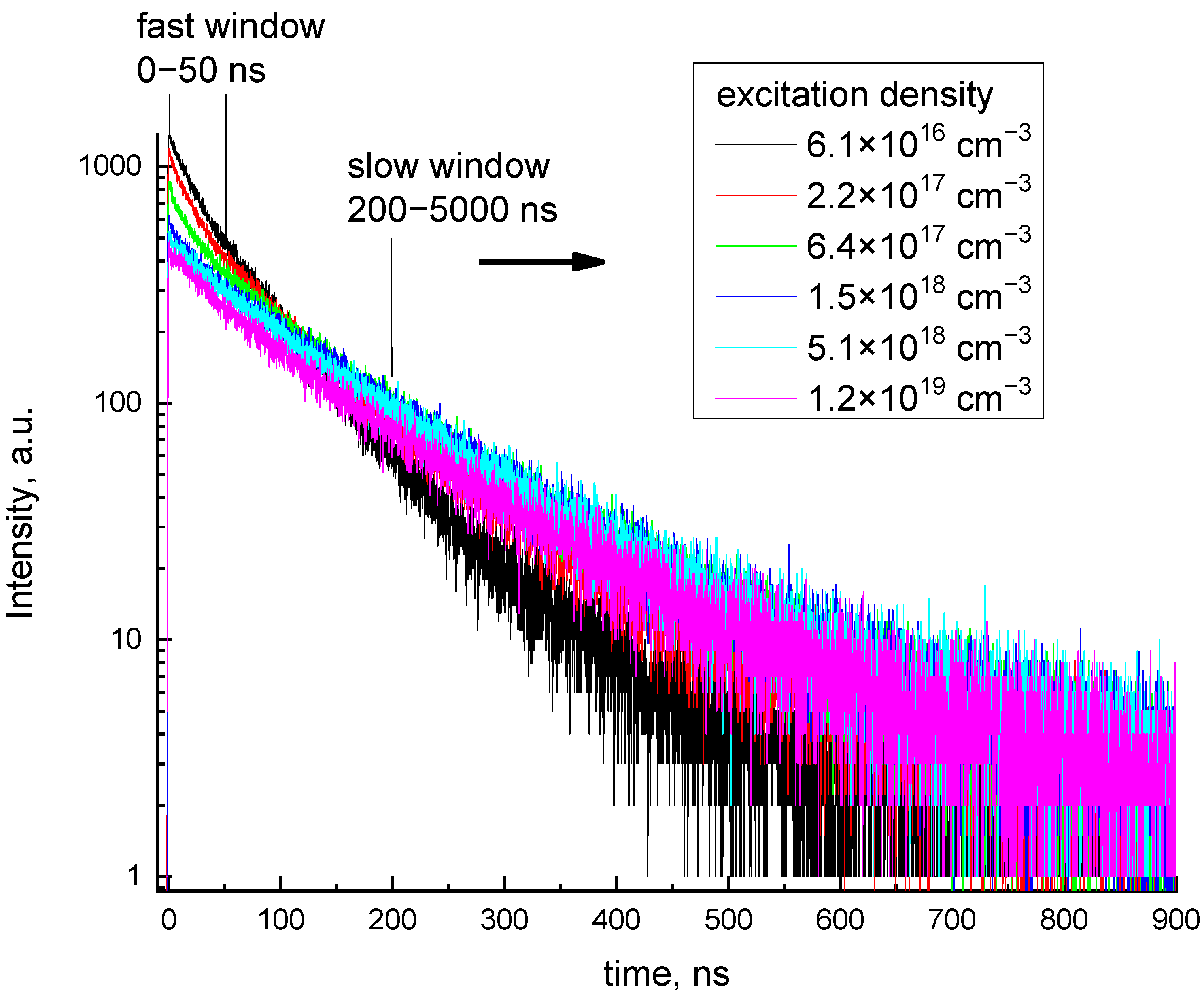
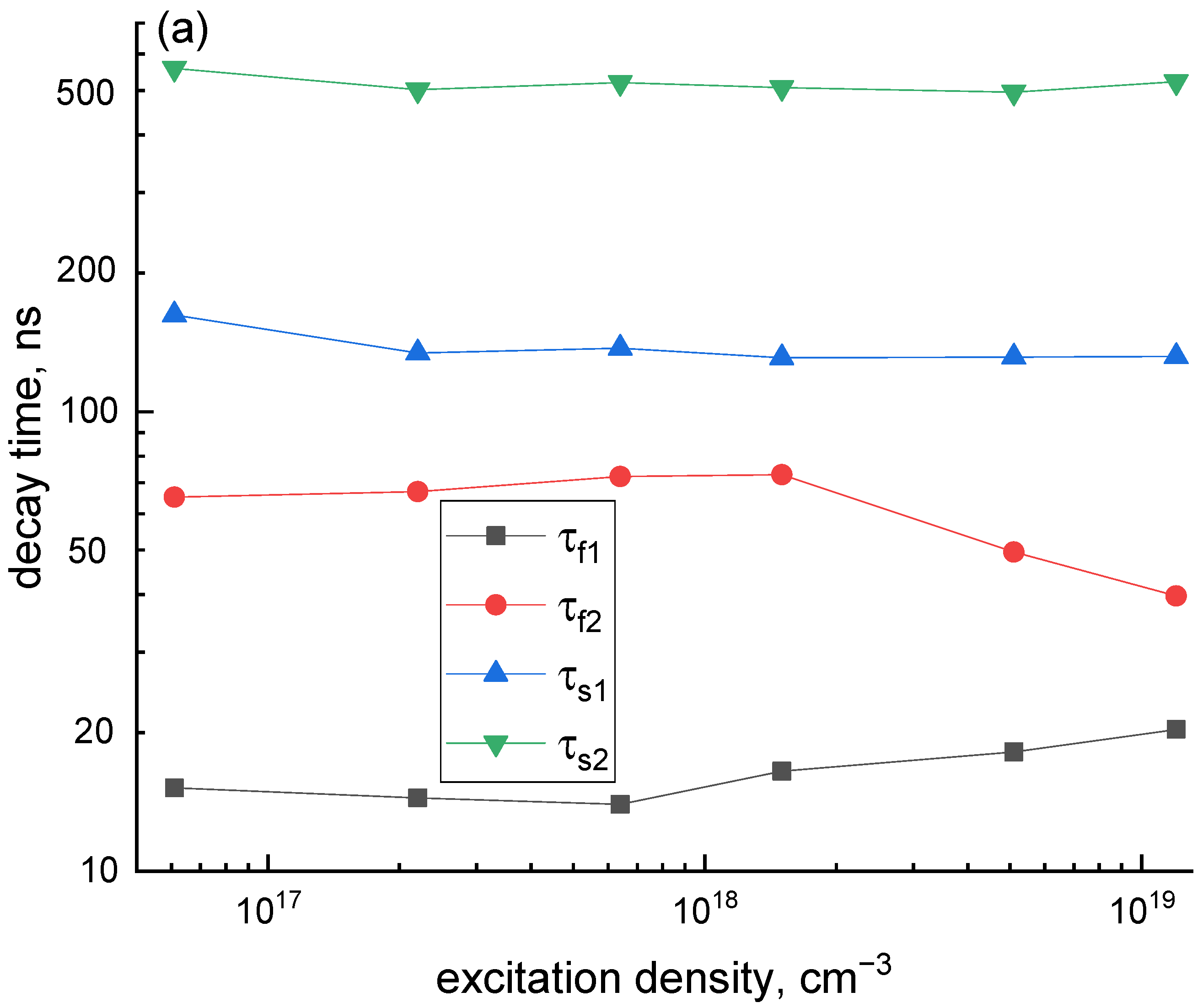
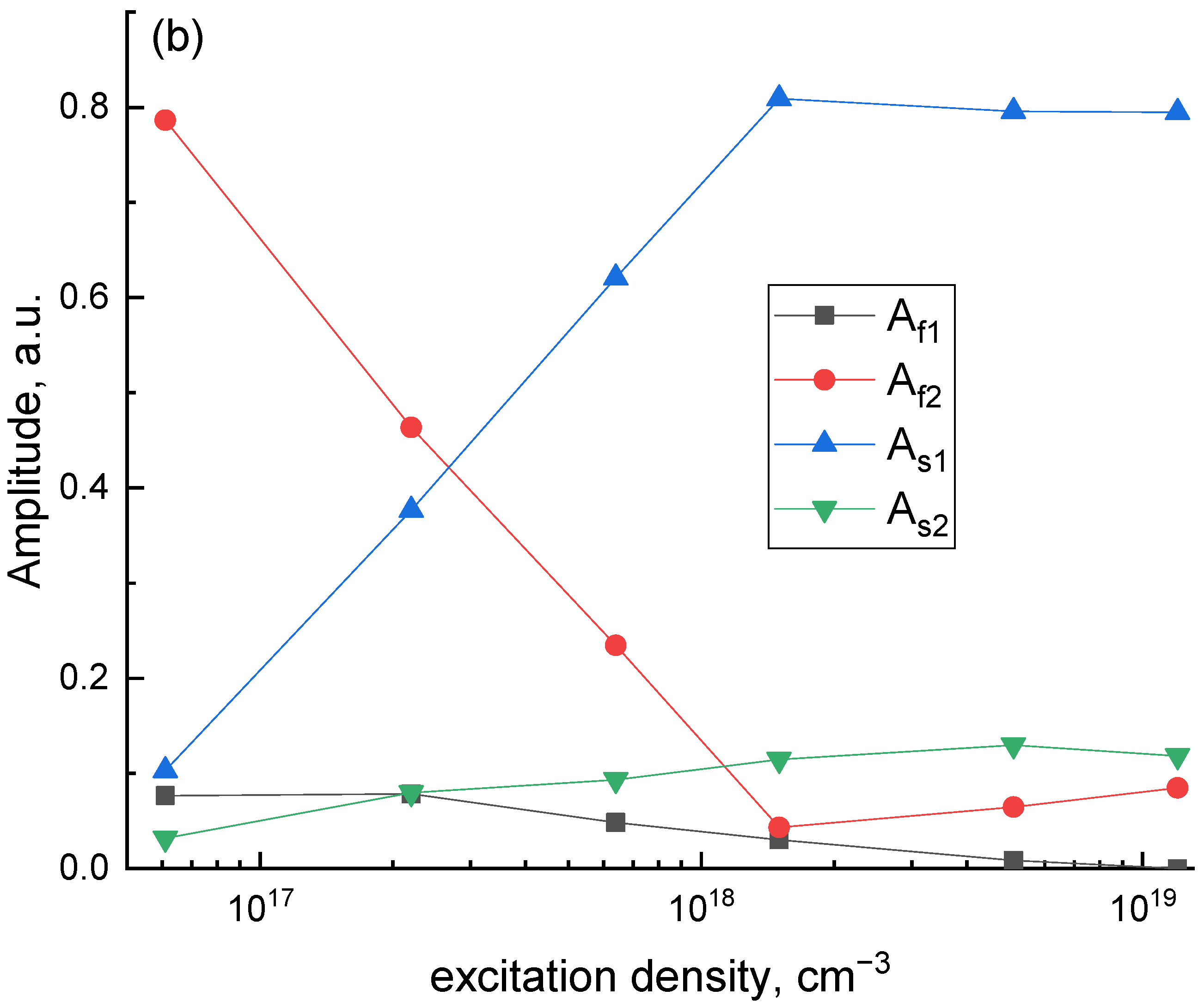
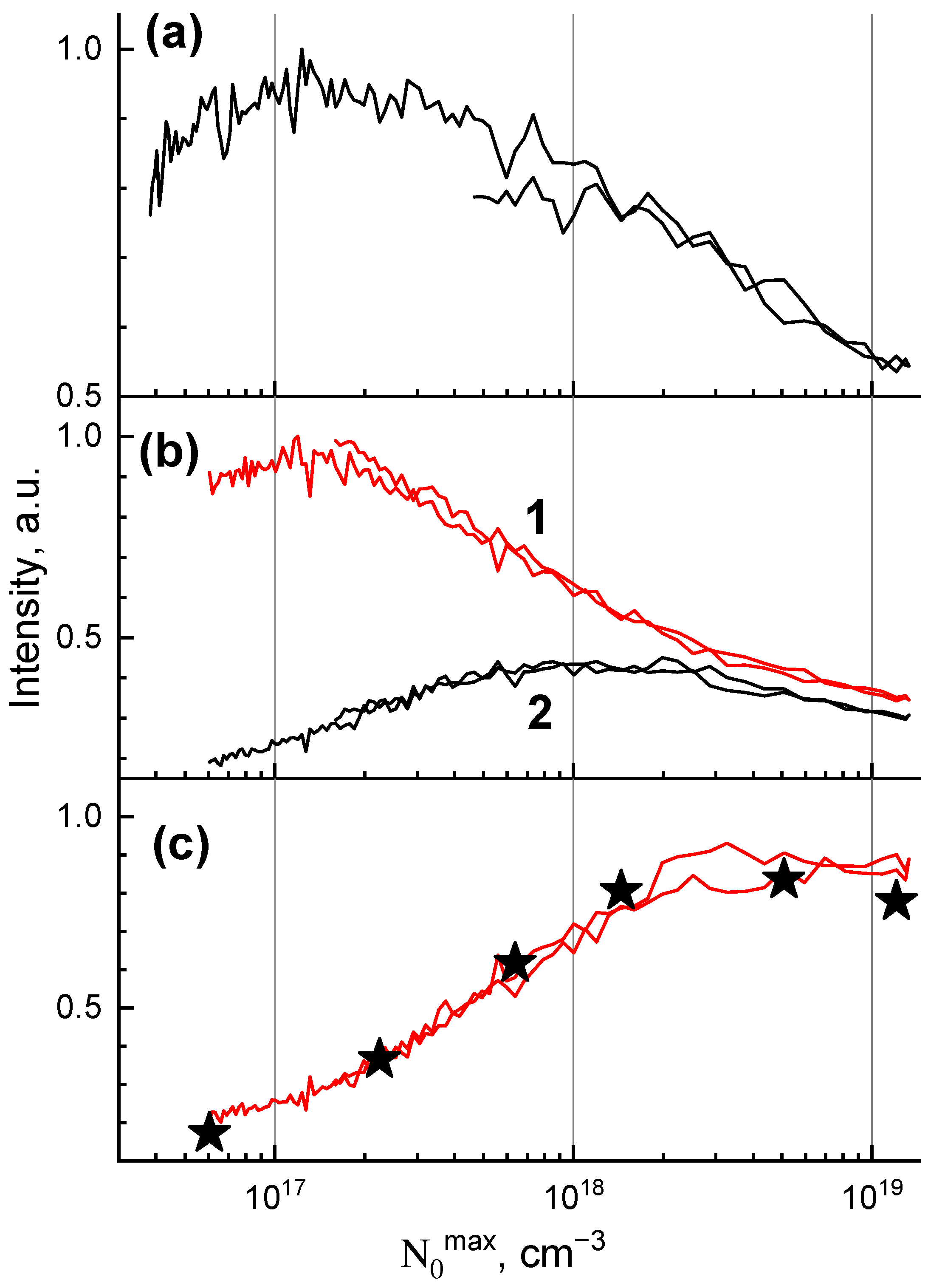
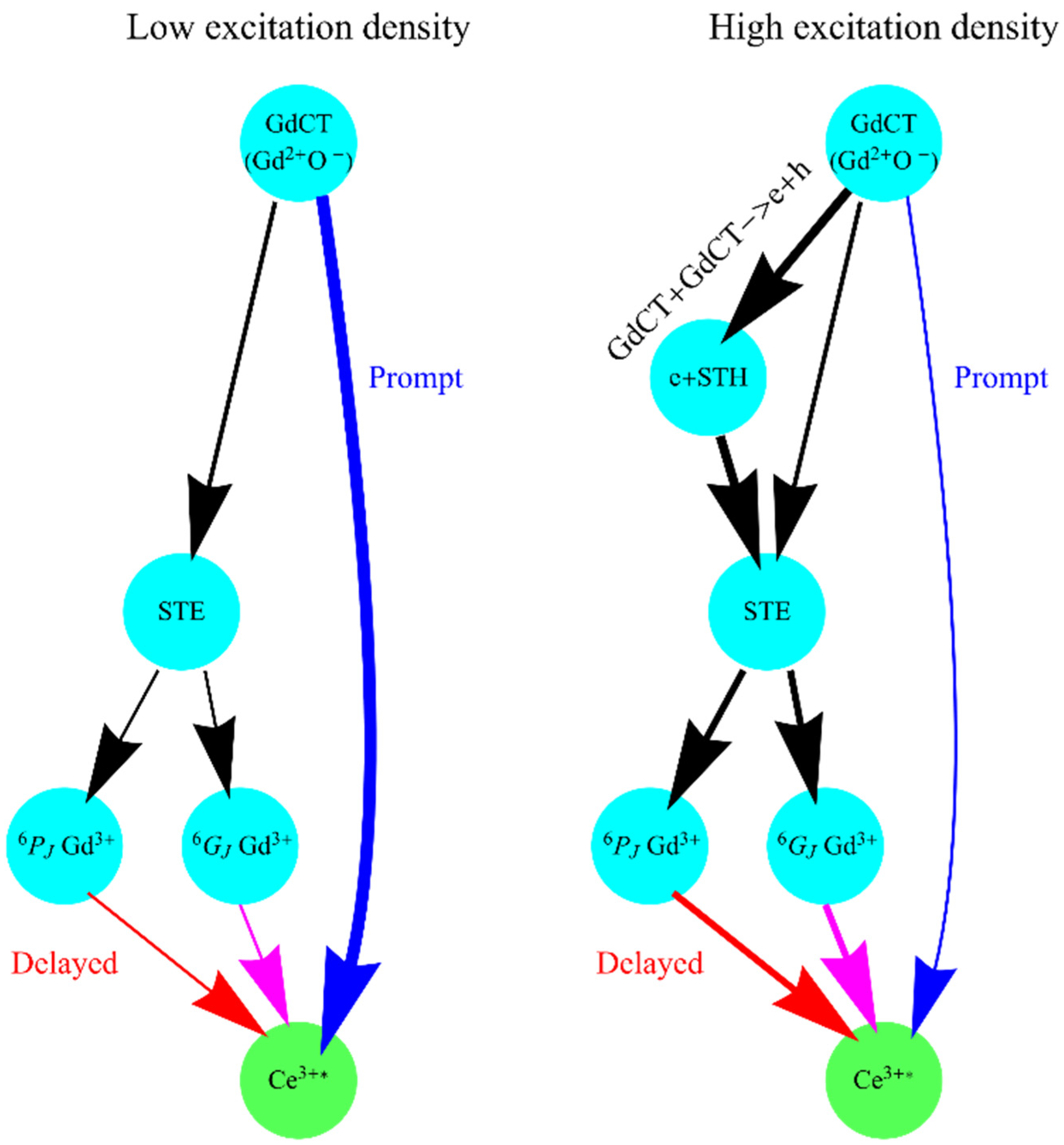
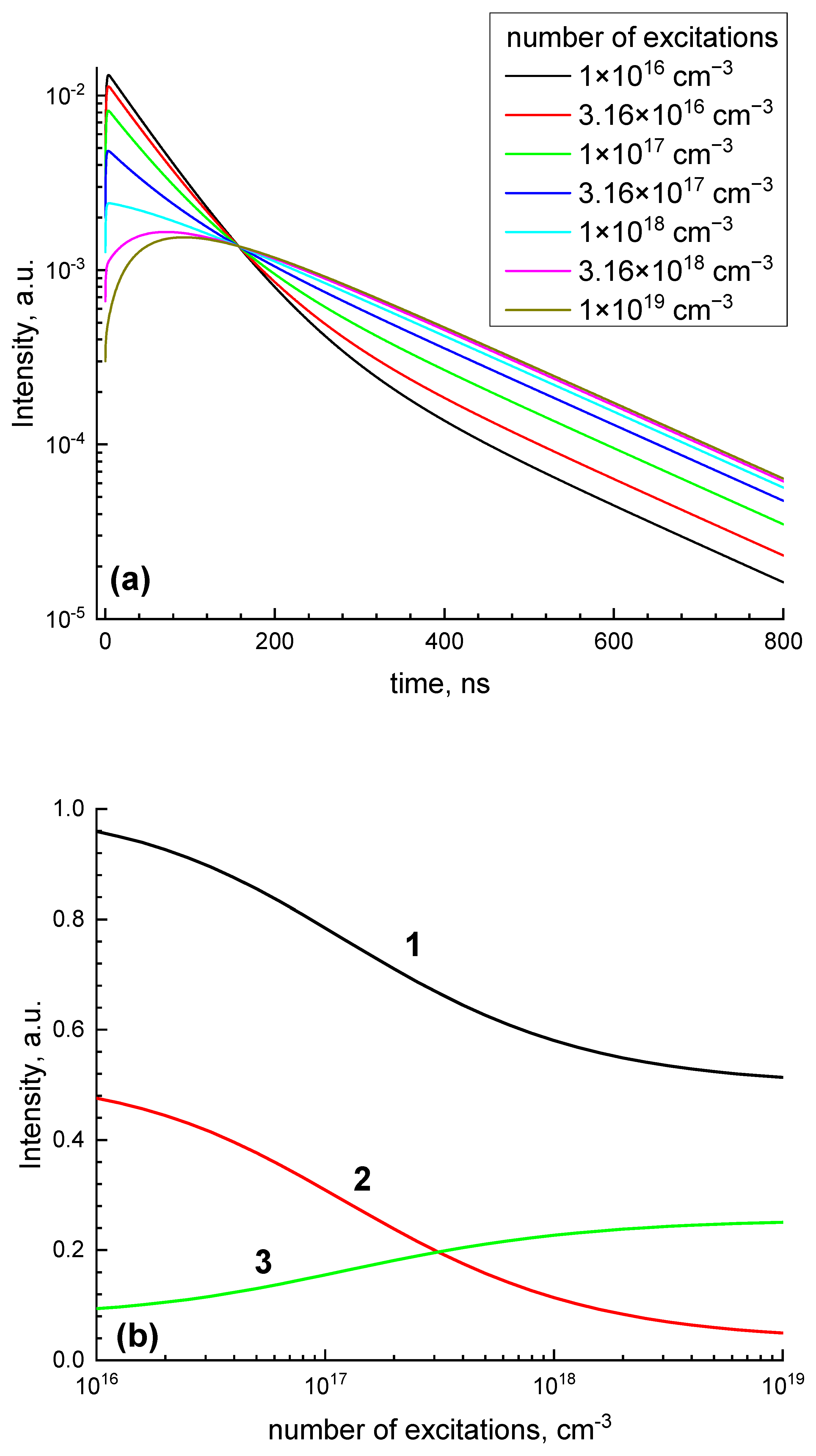
| Composition | Gd3Al2.23Ga2.77O12 |
|---|---|
| Lattice parameters: a, Å | 12.26005(1) |
| Unit cell volume, Å3 | 1842.794(3) |
| Calculated density, g/cm3 | 6.61(9) |
| R and Rw (%) for Bragg reflections (Rall/Robs) | 1.45/1.34 and 2.26/2.24 |
| 2θ range (o) | 3.042–27.841 |
| Step scan (2θ) | 0.003 |
| Imax | 211,632 |
| № reflec. (All/Obs.) | 34/32 |
| RP and RwP; Rexp (%) | 3.18, 4.93, 1.75 |
| Goodness of fit (ChiQ) | 2.82 |
| Max./min. res. density (e × Å−3) | 0.23/−0.26 |
Disclaimer/Publisher’s Note: The statements, opinions and data contained in all publications are solely those of the individual author(s) and contributor(s) and not of MDPI and/or the editor(s). MDPI and/or the editor(s) disclaim responsibility for any injury to people or property resulting from any ideas, methods, instructions or products referred to in the content. |
© 2023 by the authors. Licensee MDPI, Basel, Switzerland. This article is an open access article distributed under the terms and conditions of the Creative Commons Attribution (CC BY) license (https://creativecommons.org/licenses/by/4.0/).
Share and Cite
Spassky, D.; Vasil’ev, A.; Krutyak, N.; Buzanov, O.; Morozov, V.; Belik, A.; Fedorov, N.; Martin, P.; Belsky, A. Decay Kinetics of Gd3Al2Ga3O12:Ce3+ Luminescence under Dense Laser Irradiation. Materials 2023, 16, 971. https://doi.org/10.3390/ma16030971
Spassky D, Vasil’ev A, Krutyak N, Buzanov O, Morozov V, Belik A, Fedorov N, Martin P, Belsky A. Decay Kinetics of Gd3Al2Ga3O12:Ce3+ Luminescence under Dense Laser Irradiation. Materials. 2023; 16(3):971. https://doi.org/10.3390/ma16030971
Chicago/Turabian StyleSpassky, Dmitry, Andrey Vasil’ev, Nataliya Krutyak, Oleg Buzanov, Vladimir Morozov, Alexei Belik, Nikita Fedorov, Patrick Martin, and Andrei Belsky. 2023. "Decay Kinetics of Gd3Al2Ga3O12:Ce3+ Luminescence under Dense Laser Irradiation" Materials 16, no. 3: 971. https://doi.org/10.3390/ma16030971





